
The Munich massacre was an attack during the 1972 Summer Olympics in Munich, West Germany, by eight members of the Palestinian terrorist group Black September, who infiltrated the Olympic Village, killed two members of the Israeli Olympic team, and took nine others hostage. Black September called the operation "Iqrit and Biram", after two Palestinian Christian villages whose inhabitants were expelled by the Israel Defense Forces (IDF) during the 1948 Arab-Israeli War. The Black September commander was Luttif Afif, who was also their negotiator. West German neo-Nazis gave the group logistical assistance.

The 1972 Summer Olympics, officially known as the Games of the XX Olympiad and commonly known as Munich 1972, was an international multi-sport event held in Munich, West Germany, from 26 August to 11 September 1972.

Brixen is a town in South Tyrol, northern Italy, located about 40 kilometres (25 mi) north of Bolzano.

Turramurra is a suburb on the Upper North Shore of Sydney, in the state of New South Wales, Australia. It is located 16 kilometres (10 mi) north-west of the Sydney central business district, in the local government area of Ku-ring-gai Council. It shares the postcode of 2074 with the adjacent suburbs of North Turramurra, South Turramurra and Warrawee.
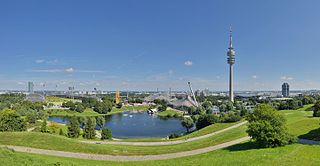
The Olympiapark in Munich, Germany, is an Olympic Park which was constructed for the 1972 Summer Olympics. Located in the Oberwiesenfeld neighborhood of Munich, the Park continues to serve as a venue for cultural, social, and religious events, such as events of worship. It includes a contemporary carillon. The Park is administered by Olympiapark München GmbH, a holding company fully owned by the state capital of Munich.

Helene Julie Mayer was a German-born fencer who won the gold medal at the 1928 Olympics in Amsterdam, and the silver medal at the 1936 Olympics in Berlin. She competed for Nazi Germany in Berlin, despite having been forced to leave Germany in 1935 and resettle in the United States because she was Jewish. She was studying in an American University and later returned to Germany in 1952 where she died of breast cancer.

Legoland Deutschland Resort is a Legoland park located in Günzburg in southern Germany, roughly halfway from Munich to Stuttgart, which opened in 2002. It is 43.5 hectares in area, and it is one of the four most popular theme parks in Germany. The Miniland contains Lego reproductions of various German cities and rural landscapes.

Waldi was the first official Olympic mascot created for the 1972 Summer Olympics in Munich. He was a dachshund, a popular breed of dog from Germany. The course of the marathon was designed to incorporate the Waldi design, and during the construction phase of the 1972 Olympic stadium and village, Waldi was used in unofficial satirical posters.

Milbertshofen, Am Riesenfeld and Am Hart are three boroughs situated in the north of Munich in Germany. Jointly, they form the city district 11 Milbertshofen-Am Hart. As of December 2016, the three boroughs had 76.255 inhabitants.

The Hochhaus Süddeutscher Verlag in the quarter of Berg am Laim in Munich serves as headquarters of the Süddeutscher Verlag which publishes the Süddeutsche Zeitung.
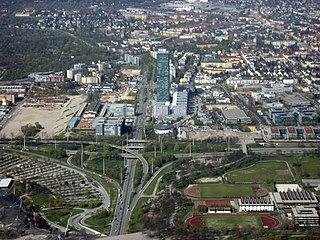
Moosach[ˈmoːsax] is the 10th northwestern district of Munich, Bavaria, Germany. It is sectioned in the urban districts Hartmannshofen, Pressestadt and Borstei.

Am Riesenfeld is the westernmost of the three subdistricts of the Munich city district 11 Milbertshofen-Am Hart.
The Lerchenauer Straße is a 5.5 km long arterial road in Munich.
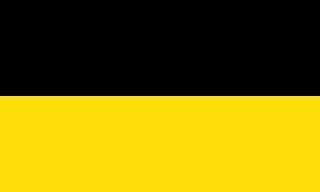
The following outline is provided as an overview of and topical guide to Munich:

The Connollystraße is a street in the Olympic Village and student quarter of the Olympic Park Munich.

The Studentenviertel Oberwiesenfeld, also known as a student village or because of its location in the Olympic Park, sometimes called Olydorf, is a student residency in Munich. It is located on the former site of the Olympic Village of the 1972 Summer Olympics in Munich. After the student city Freimann, it is, with currently about 1953 residents, the second largest housing estate of the Studentenwerk München.
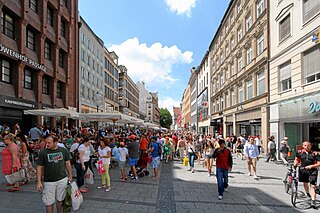
The Kaufingerstraße is one of the oldest streets in Munich and, together with the Neuhauser Straße, one of the most important shopping streets in Munich.

Hanauer Straße in Munich is an arterial road about one and a half kilometers long extending from south to north in the Moosach district. It was named after the Hesse city of Hanau.

Neuhauser Straße is part of the first and largest pedestrian zone in Munich's Old Town. Here, many retail shops and restaurants are to be found.
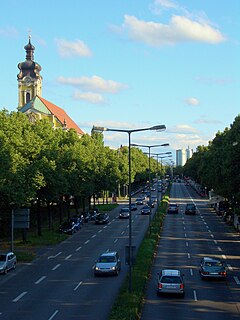
The Landshuter Allee is an avenue in Munich and through most of its course it is part of the Mittlerer Ring, the Bundesstraße 2 R. It joins Donnersbergerbrücke at Arnulfstraße in the Neuhausen district and runs from Dachauer Straße west of the Olympiapark to Moosacher Straße west of the Olympic village in the Moosach district. The B 2R leaves the intersection-free avenue at the Landshuter Allee and continues on the Georg-Brauchle-Ring. The Landshuter Allee now functions as the B 304 and connects the Mittlerer Ring with the northern tangent of the Outer Ring, which is only partially complete. The large width of the Landshuter Allee of 54 metres between the houses is striking. It crosses the Nymphenburg-Biedersteiner Kanal.




















